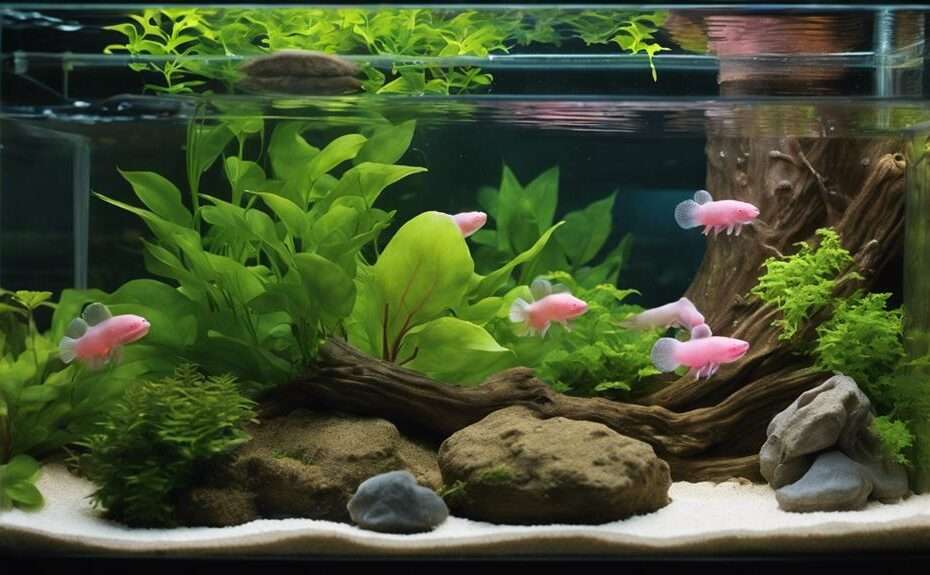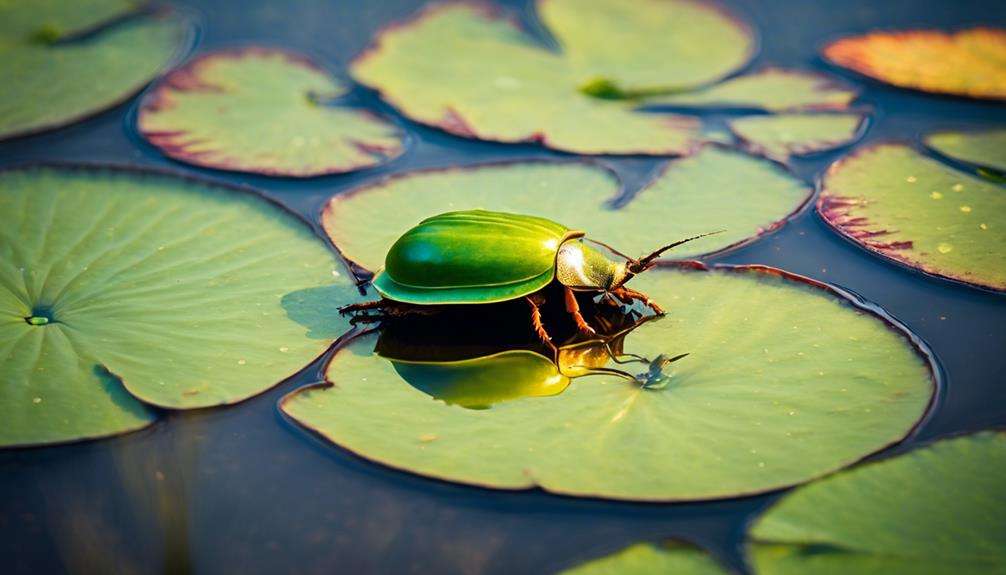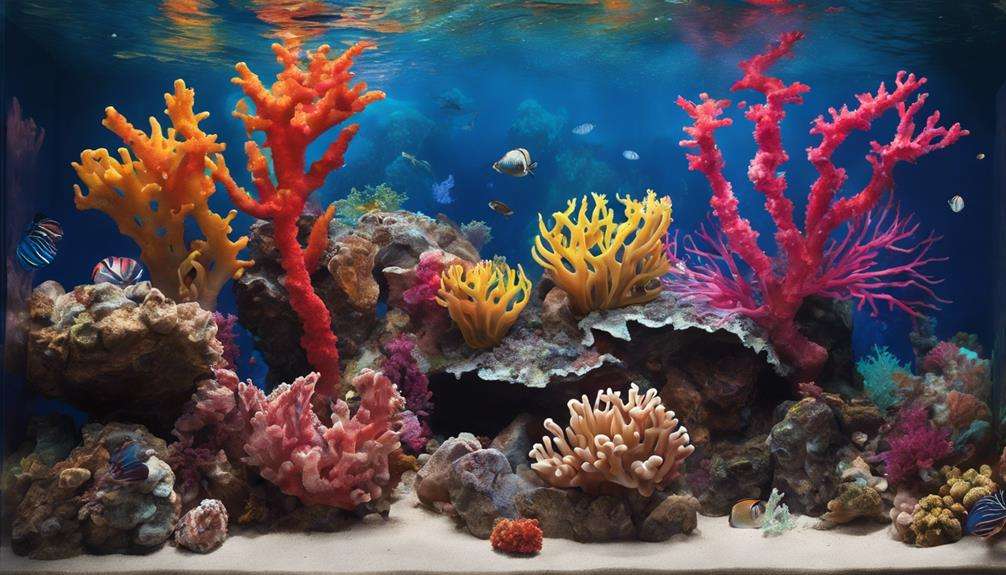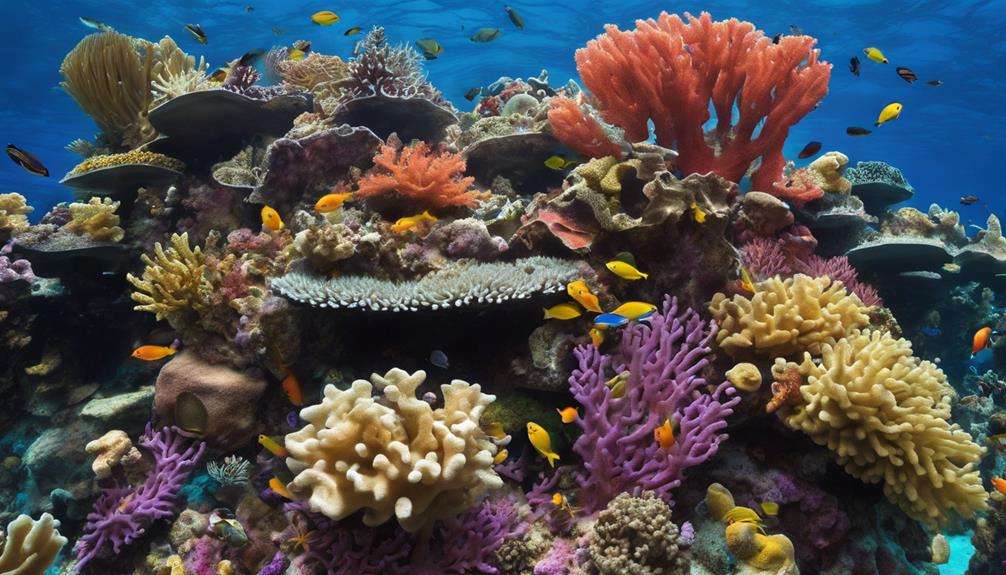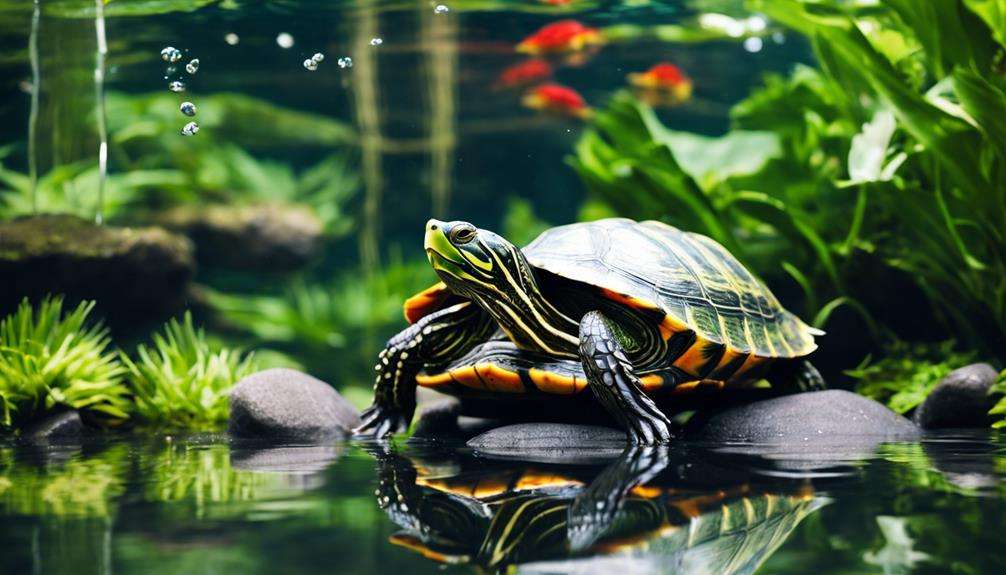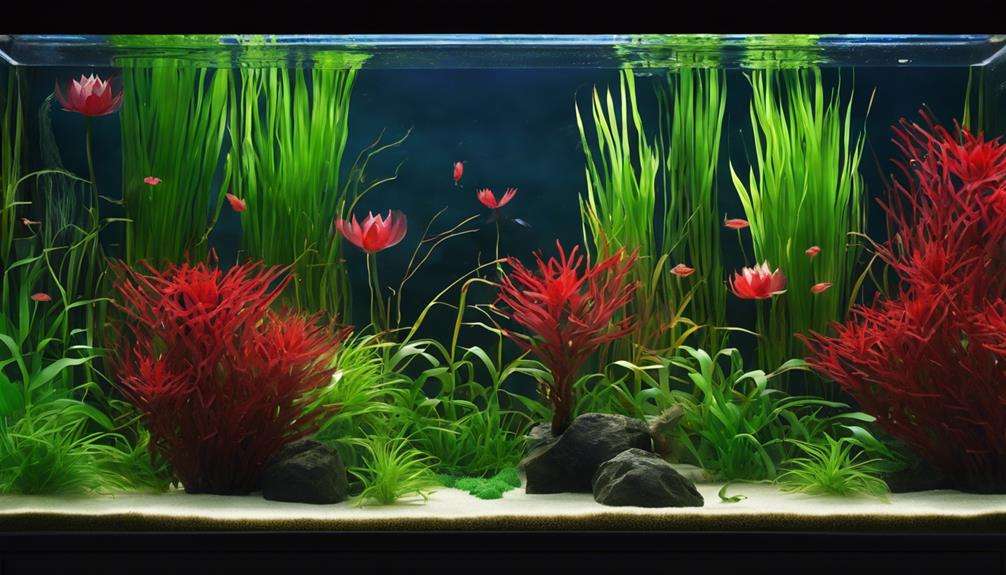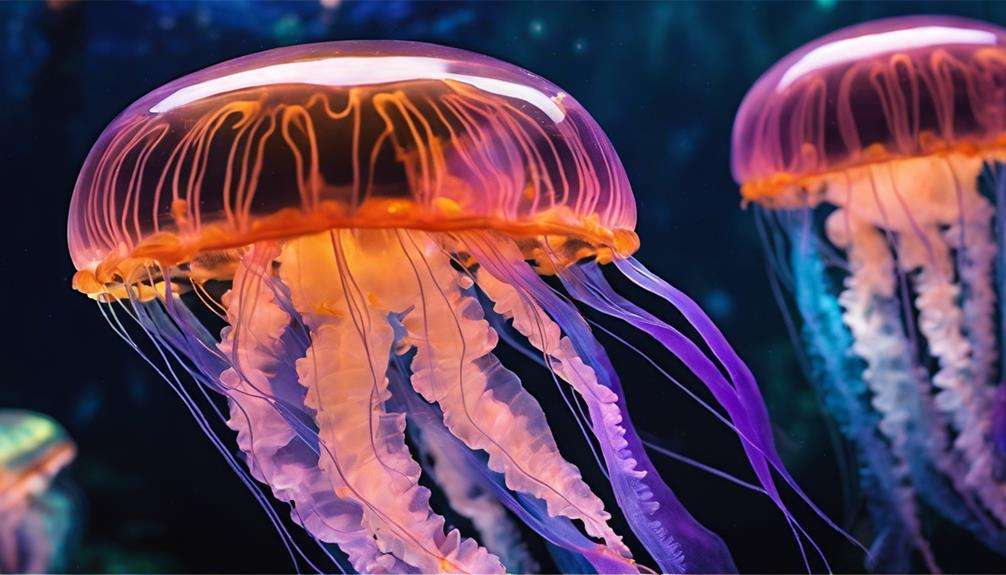If you're looking to provide optimal care for your axolotl companions, ensuring their well-being involves a series of vital steps. From creating a suitable habitat to maintaining precise water conditions, the care guide offers a complete approach to nurturing these unique creatures.
However, beyond the basics lies a world of fascinating insights and care techniques that can elevate your axolotl care to the next level. Understanding their behavior, health nuances, and specialized requirements can truly transform your experience with these enchanting amphibians.
Key Takeaways
- Provide a calm habitat with optimal conditions for stress-free axolotls.
- Maintain water quality within specific parameters for their health.
- Feed a suitable diet and avoid harmful foods for their well-being.
- Ensure responsible ownership, ethical sourcing, and adherence to regulations for axolotl care.
Species Overview
Inhabiting the waters of Lake Xochimilco in Mexico, axolotls are neotenic salamanders facing a critical situation due to habitat loss. These unique creatures have captured the attention of scientists and enthusiasts worldwide. The neotenic trait means they retain larval features into adulthood, such as external gills and finned tails. Their habitat, Lake Xochimilco, is under threat primarily due to urbanization and pollution. As a result, the population of axolotls in the wild has drastically declined, pushing them towards the brink of extinction.
Lake Xochimilco's once pristine waters provided the perfect environment for these fascinating creatures, but human activities have significantly altered the ecosystem. The intricate balance necessary for axolotls to thrive is being disrupted, leading to a decline in their numbers. Conservation efforts are essential to prevent the loss of such a unique species. Understanding the impact of habitat loss on axolotls is critical for developing strategies to protect and preserve these neotenic salamanders for future generations.
Behavior and Temperament
The behavior and temperament of axolotls reveal fascinating insights into their nocturnal nature and unique regenerative abilities, shedding light on their solitary tendencies and response to stress. These creatures are most active during the night, displaying a preference for low light levels during the day. Their curious and inquisitive nature leads them to explore their surroundings actively, often investigating objects within their tank.
Axolotls are solitary animals by nature, and it's essential to keep them alone to prevent potential stress or aggression. Being able to regrow lost limbs through regeneration is a remarkable trait that sets them apart from other amphibians. However, stress can still impact axolotls, leading to behaviors such as floating lethargically, erratic swimming, or excessive hiding.
Monitoring their environment for stressors and ensuring a calm, suitable habitat is vital for maintaining the well-being of these fascinating creatures. By understanding their behavior and temperament, you can provide the best care for your axolotl companion.
Housing Requirements
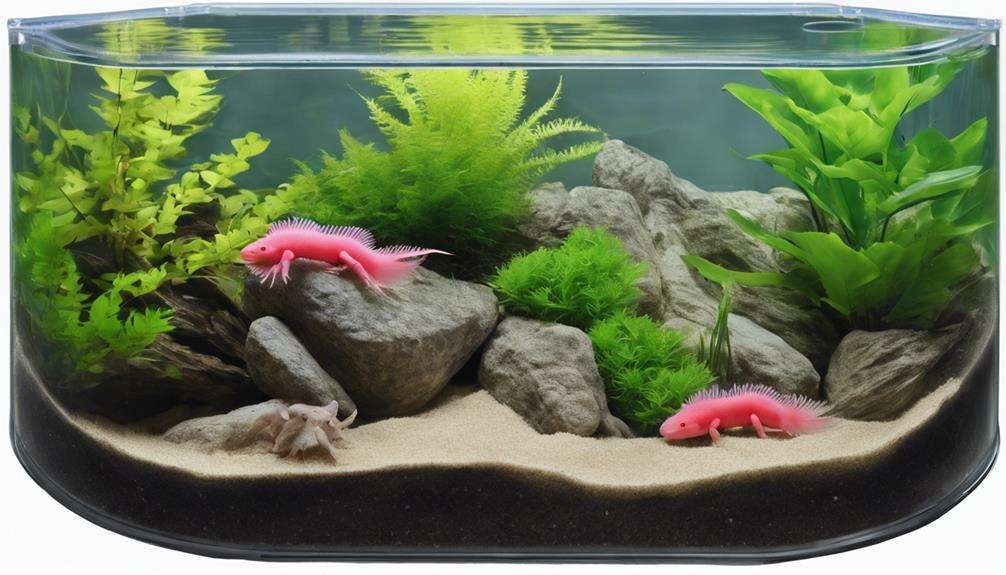
For perfect care of axolotls, make sure your tank meets specific housing requirements to support their aquatic lifestyle effectively.
Axolotls require a tank size of at least 15 to 20 gallons to comfortably swim and explore. It's important to have a secure lid on the tank to prevent axolotls from jumping out. These fully aquatic animals don't need a land area in their tank.
The water depth should be slightly more than the length of the axolotl to facilitate easy movement. When selecting a substrate for axolotls, opt for coarse gravel to prevent them from ingesting it, thereby reducing the risk of impaction.
Ensuring the tank is adequately sized, with the right water depth and suitable substrate, creates a comfortable and safe environment for your axolotls to thrive in their aquatic habitat.
Water Conditions
To maintain peak health for your axolotls, make sure the water conditions in their tank meet specific requirements. Axolotls thrive in cool water temperatures between 57-68°F. It's essential to monitor and maintain pH levels between 6.5 and 7.5 to guarantee their well-being.
When preparing the water for your axolotl's tank, always use tap water treated with aquarium water conditioner to eliminate harmful chemicals that could be detrimental to your pets. Regular water changes are vital to keep the water quality high and provide a healthy environment for your axolotls.
Monitoring water parameters such as ammonia, nitrites, and nitrates is critical for their health. Clean water, aided by proper filtration, is key to preventing stress and health issues in axolotls.
Feeding and Nutrition
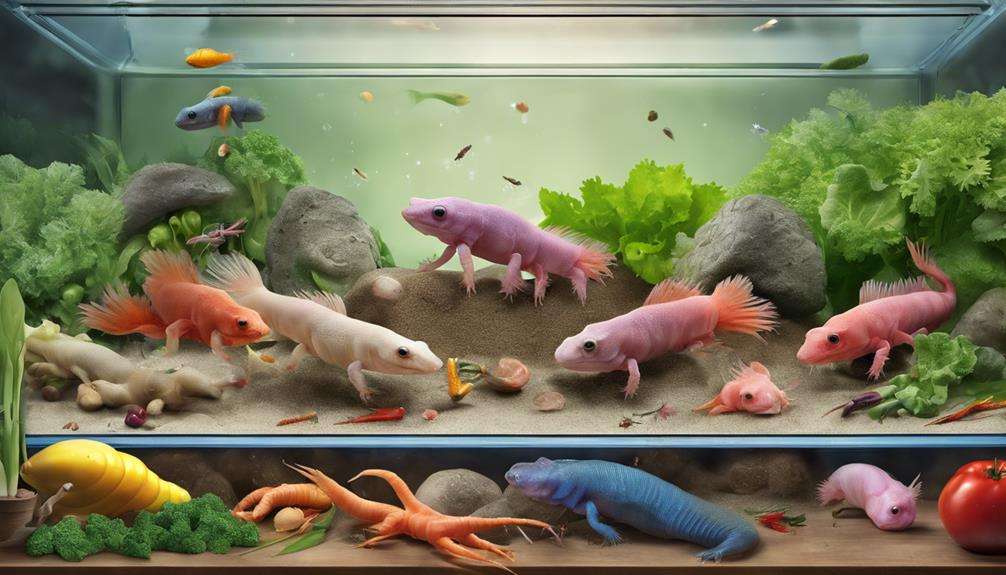
How often should axolotls be fed to maintain prime health and nutrition levels?
Axolotls should be fed 2-3 times a week with a diet that includes live nightcrawlers, frozen bloodworms, and occasional treats like shrimp, beef, and chicken. It's important to avoid feeding them live feeder fish or fatty foods regularly to guarantee their well-being. Providing a varied diet is essential to supply axolotls with all the necessary nutrients without requiring additional vitamin or mineral supplementation.
Additionally, selecting a safe substrate such as sand for the tank is important to prevent axolotls from ingesting harmful materials. To maintain a healthy environment for axolotls, it's crucial to monitor water quality closely, employ a reliable filtration system, and conduct regular water changes.
Common Health Problems
Shifting from the subject of feeding and nutrition, common health problems frequently encountered in axolotls include fungal infections, bacterial infections, and parasitic infestations. Maintaining proper water conditions is important to prevent these issues. Axolotls are sensitive to water quality, so any fluctuations can lead to stress and health problems. Monitoring water parameters regularly and making sure the tank is clean is vital.
Signs of stress in axolotls, such as lack of appetite, lethargy, abnormal swimming behavior, or skin discoloration, shouldn't be ignored. These could be indicators of underlying health issues that need attention. Providing a stress-free environment with suitable hiding spots and stable water conditions can help prevent these problems. If you notice any unusual symptoms, seeking veterinary care promptly for a proper diagnosis and treatment is important. By being proactive in monitoring your axolotl's health and addressing any issues promptly, you can help ensure a happy and healthy pet.
Legalities of Owning Axolotls

Before acquiring an axolotl, it's important to understand the legalities surrounding their ownership. Familiarize yourself with ownership regulations, permit requirements, and any legal restrictions in your area.
Failure to comply with these laws can result in fines or other legal consequences, so it's necessary to be well-informed before bringing an axolotl into your home.
Ownership Regulations Overview
Ensuring compliance with local laws and regulations is vital when considering the ownership of axolotls as pets. Some states, like California, Maine, New Jersey, and Virginia, have restrictions on owning axolotls due to conservation concerns.
For instance, in New Mexico, owning axolotls is legal but importing them from other states is prohibited. It's essential to check your local exotic pet laws before acquiring an axolotl to avoid legal issues.
Due to habitat loss, axolotls are critically endangered in the wild, necessitating responsible ownership practices. To ensure both legality and ethical sourcing, it's recommended to purchase axolotls from reputable breeders or rescue groups.
Permit Requirements Explained
To legally own an axolotl, understanding the permit requirements specific to your state is imperative. Some states, such as California, Maine, New Jersey, and Virginia, prohibit axolotl ownership due to conservation concerns, as these creatures are critically endangered.
In New Mexico, owning axolotls is allowed, but importing them from other states is illegal. Before acquiring an axolotl, always check local exotic pet laws to make sure compliance.
When purchasing an axolotl, which typically costs between $30 and $80, it's vital to buy from reputable breeders or rescue groups to support ethical practices and the conservation of this unique species.
Legal Restrictions Clarified
Understanding the legal restrictions surrounding the ownership of axolotls is essential for prospective keepers to guarantee compliance with local regulations and contribute to the conservation efforts of this endangered species. Axolotls are illegal to own in states like California, Maine, New Jersey, and Virginia.
While New Mexico allows ownership, importing axolotls from other states is prohibited. It's important to check local exotic pet laws before considering keeping an axolotl to avoid illegal ownership.
Due to habitat loss and pollution, axolotls are critically endangered, emphasizing the significance of responsible ownership. When acquiring an axolotl, opt for reputable breeders or rescue groups, despite the average cost ranging between $30 and $80.
Purchasing Your Axolotl
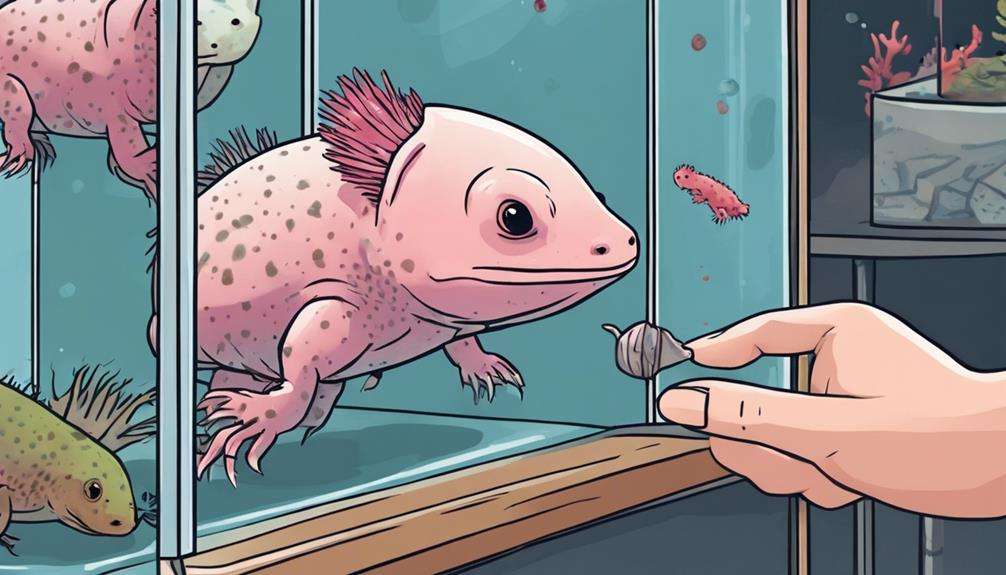
When purchasing your axolotl, your first priority should be selecting a healthy specimen to guarantee its well-being. Consider the tank requirements carefully to provide a suitable environment for your new pet.
It's important to research and choose reputable sellers to make sure the origin and quality of your axolotl.
Selecting a Healthy Axolotl
When selecting a healthy axolotl, examine their eyes for clarity and gills for intactness to guarantee prime health. Clear, bright eyes are indicative of a well-maintained axolotl, while intact gills assure proper oxygen absorption.
Avoid individuals with visible injuries, deformities, or signs of illness, as these can indicate underlying health issues. Choose axolotls that are active, responsive to movement, and display curiosity, as these traits often signify good overall health.
Additionally, check for smooth skin without lesions, mucus, or abnormal growths, which are signs of skin issues or infections. To make sure you're getting a healthy pet, purchase your axolotl from reputable breeders or rescue organizations known for providing well-cared-for specimens.
Consider Tank Requirements
Consider a tank size of at least 29 gallons as the minimum requirement for ideal axolotl care and well-being. Axolotls benefit from larger tanks, which help dilute waste and reduce stress. Tank length and width are more important than height.
Adequate filtration is essential for waste management and maintaining stable water conditions. When setting up the tank, choose a suitable substrate like CaribSea Super Natural moonlight sand with a 1mm grain size to provide a comfortable environment for your axolotl.
Proper tank sizing, efficient filtration, and appropriate substrate selection are essential components in creating a thriving habitat for your axolotl. Remember, these factors play a significant role in the overall health and happiness of your aquatic pet.
Research Reputable Sellers
To guarantee the well-being and health of your axolotl, it's imperative to thoroughly research reputable sellers before purchasing your aquatic pet. Look for reputable breeders or rescue groups to make sure you're getting a healthy axolotl.
Avoid buying axolotls online without detailed information on their origins and overall health status. The average cost of an axolotl typically falls within the range of $30 to $80, but be cautious of unusually low prices as they may indicate unethical breeding practices.
Given that axolotls are critically endangered due to habitat loss, ethical sourcing is vital to support conservation efforts and make the sustainability of the species.
Always check local exotic pet laws before purchasing an axolotl, as they're prohibited in some states.
Similar Species to Axolotls
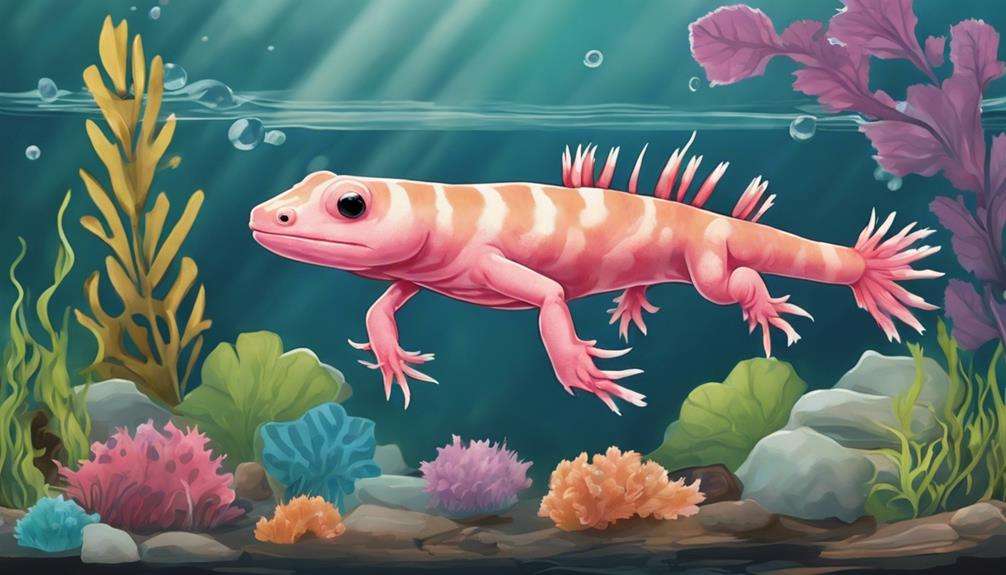
Similar species to axolotls, such as tiger salamanders, leopard geckos, and fire belly newts, share key characteristics that make them intriguing choices for amphibian enthusiasts. Tiger salamanders, like axolotls, belong to the Ambystoma genus and exhibit neoteny, retaining their larval features into adulthood. Leopard geckos, although not amphibians but reptiles, are popular for their ease of care and docile nature, similar to axolotls. Fire belly newts, known for their striking coloration and toxic skin secretions, require similar aquatic habitats and feeding preferences to axolotls.
These species share common features with axolotls, such as large gills for respiration, finned tails for propulsion in water, and wide heads for efficient hunting. Understanding the specific needs of tiger salamanders, leopard geckos, and fire belly newts is vital for their well-being, just as it's for axolotls. Ensuring ideal water quality, appropriate diet, and suitable tank conditions are essential aspects of caring for these captivating creatures. By researching and providing a habitat that mimics their natural environment, you can enjoy the unique characteristics and behaviors of these similar species to axolotls.
Frequently Asked Questions
How Do You Take Care of an Axolotl for Beginners?
To care for an axolotl as a beginner, establish a feeding schedule of brine shrimp, worms, and commercial pellets. Add tank decorations for enrichment. Control temperature within 57-68°F. Maintaining a suitable environment is essential for their well-being.
How Hard Are Axolotls to Take Care Of?
Are axolotls hard to take care of? Not really. With proper tank setup, feeding tips, and monitoring for health concerns, you can easily provide a suitable environment for these unique creatures to thrive in your care.
What Do Axolotls Need in Their Tank?
In an axolotl tank, decorations provide hiding spots and stimulation. Maintain water temperature between 60-68°F. Feed axolotls 2-3 times a week with earthworms or pellets. These practices secure a healthy, enriched environment for your aquatic pet.
How Often Do You Change the Water in an Axolotl?
You should change the water in your axolotl tank regularly to keep them healthy. Monitor water quality and adjust the frequency based on their needs. Clean the tank and filter during changes to maintain a safe environment.
Conclusion
Now that you have mastered the art of caring for axolotls, you can witness the beauty of these unique creatures thriving in their well-maintained habitat.
By providing the ideal environment, nutrition, and attention to their needs, you have the power to reveal the wonder of these fascinating amphibians.
Embrace the responsibility of being a dedicated axolotl owner, and watch as your efforts flourish alongside these enchanting beings in a harmonious coexistence.
